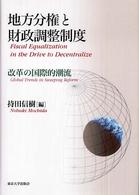基本説明
New languages are constantly emerging, as existing languages diverge into different forms. To explain this fascinating process, we need to understand how languages change and how they emerge in children. In this pioneering study, David Lightfoot explains how languages come into being, arguing that children are the driving force. He explores how new systems arise, how they are acquired by children, and how adults and children play different, complementary roles in language change. Lightfoot makes an important distinction between 'external language' (language as it exists in the world), and 'internal language' (language as represented in an individual's brain).
Full Description
New languages are constantly emerging, as existing languages diverge into different forms. To explain this fascinating process, we need to understand how languages change and how they emerge in children. In this pioneering study, David Lightfoot explains how languages come into being, arguing that children are the driving force. He explores how new systems arise, how they are acquired by children, and how adults and children play different, complementary roles in language change. Lightfoot makes an important distinction between 'external language' (language as it exists in the world), and 'internal language' (language as represented in an individual's brain). By examining the interplay between the two, he shows how children are 'cue-based' learners, who scan their external linguistic environment for new structures, making sense of the world outside in order to build their internal language. Engaging and original, this book offers an interesting account of language acquisition, variation and change.
Contents
Preface; 1. Internal languages and the outside world; 2. Traditional language change; 3. Some properties of language organs; 4. Languages emerging in children; 5. New E-language cuing new I-languages; 6. The use and variation of grammars; 7. The eruption of new grammars; 8. A new historical linguistics; References; Index.






